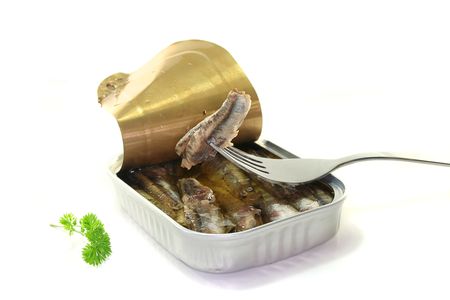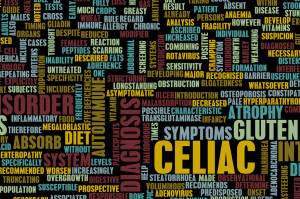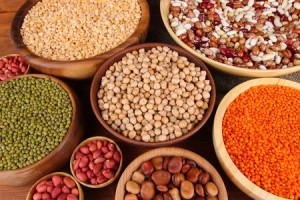

Using the idea of a “superfood” as something that packs a lot of nutrients on a per calories basis, sardines hit the mark. They are nutrition powerhouses.

Superfoods. A buzz word that has become part of our everyday language but what does it mean? While there is no standardized definition, and the use of the word is unregulated, the general consensus is that a superfood will give the consumer a lot of nutritional bang for their buck on a per calorie basis. Often the word superfood is used to describe plant foods such as kale, blueberries, quinoa or acai berries for example and with good reason: they are very nutritious. However superfoods can also be used to describe animal-based foods as well; kefir, cheese, beef, and fish are loaded with nutrients and needed necessarily be high in calories. One of our favourite superfoods is sardines.
Sardines are small fish that form large schools, swimming through the ocean with open mouths collecting small amounts of plankton.
They are small, plentiful fish that can be bought fresh or canned. Fresh sardines are available in late summer, but can be enjoyed year round canned, smoked, or frozen.
What are the advantages of sardines?
By now, most have heard of the many health promoting properties of fatty fish like salmon, herring, trout, and mackerel, as well as sardines, probably best known for their omega-3 fats eicosapentaenoic acid (EPA) and docosahexaenoic acid (DHA) – fats that have been shown to promote overall health, specifically for the cardiovascular system, as well as for eye, skin, and brain health, and for lowering inflammation. However, many fatty fish high in omega-3s have fragile fish stocks, meaning they are commonly overfished, which can harm the ecosystem. Sardines, primarily due to their small size, are considered to be a sustainable species, which can be enjoyed without guilt.
Sardines are much more than their omega 3 fatty acid content
One 92 g or 3.2 oz can of sardines provides almost twice the recommended average daily intake of 500 mg of EPA and DHA combined.
Sardines also include other nutrients needed for the production of neurotransmitters; chemicals that regulate mood and brain function. These include iron, magnesium, B vitamins, vitamin D, zinc, and selenium. (https://halcyonliving.co.uk/)
The following illustrates how sardines have nutrient density extraordinaire – just one 92 g / 3.2 oz can of sardines yields the following (on average)*:
- 23 g protein
- 351 mg calcium (more than a glass of cow’s milk)
- 2.7 mg iron
- 451 mg phosphorus
- 465 mg sodium
- 1.2 mg zinc
- 49 mg selenium
- 4.8 mg vitamin B3 (niacin)
- 70 mg choline (a vitamin B-like molecule)
- 8 mcg vitamin B12
- 100 IU vitamin A (retinol)
- 178 IU vitamin D
- 435 mg EPA
- 468 mg DHA
For more tips on healthy nutrition and weight loss, click here for our presentation.
*Source: USDA database
Not only do sardines provide a significant amount of total nutrients, but because the nutrients are found in an animal-based food, they are absorbed efficiently – some more so than from plant foods – a fact that is often overlooked in nutrition. While plant foods have other health-promoting advantages – like higher amounts of phytonutrients than in meats, fish, or dairy – one shouldn’t lose sight of the fact that animal-based foods are highly nutritious in their own right.
Comments 37
Leave a Reply
You must be logged in to post a comment.




Sardines on cracker bread , it’s delicious.
How about pilchards in tomato sauce. Are they OK as well . I’ve been replacing sardines with pilchards especially for breakfast
What great news about the humble tinned sardine! One of my favourite simple meals is a can of sardines (in chilli or lemon oil preferably) stirred into penne pasta. The whole is so much greater than the sum of the parts!
Hey rifiki7 – you’re right, no butter is needed…the sardines will provide a great richness from the omega-3 and other naturally occurring fats!
Hi Kathylyn – you’re right, depending on where you live, GMOs may not be labelled. There’s an article on that very topic – check it out. Where I am in North America, GMOs do not have to be labelled…buyer beware
I love sardines and also an avid label reader and watch out for things like added Canola oil, (as Canola is one of the 9 GM food products). I guess – depending on where you live – it may or may not be law to have food labeled “GMO-free”. So it is important to be informed.
sorry new at this yeah I have my sardines w/tomato sauce then top on saltine krackers and top with tapatio sauce and squeeze lemon juice.
Hi, BrideyBird. Sardines in tomato sauces is definitely OK, and even preferred over sardines in oil.
Hi, Dumas. What is the concern about tiny sardines.
Is it to have the canned sardines in the tomato sauce?
I love sardines but, I like only the tiny ones. Any suggestions?
sorry folks i am new at this , my comment should have been NO butter is needed.
hi fellow sardine lovers the bones would give you extra calcium even in a small way. mash fish &sauce/oil spread on rice or corn crackers or bread if you must ,butter needed.
Hi, Cullen. Tuna and salmon have similar benefits. With tuna, it is ideal to get it canned in water or olive or canola oil.
I always have canned sardines on hand for right-now food. Especially fond of the lemon sauce kind and on toast for breakfast. Used to eat these at the office but alas fishy smells are frowned upon all too often. And brushing one’s teeth in the office bathroom sink is just too gross and germ infested a location.
I like to eat sardines with salsa/medium hot, I am a gringo
What about canned tuna and salmon?
Just eat them now.
I eat them along with a salad with all the great veggie that are in season now.
I recently met a spry, engaging 99 year old who is still a champion veteran swimmer. I asked him the secret of his
vitality and he replied ‘Whisky Mac and Sardines’ and he wasn’t joking according to his daughter.
when can i include sardines to my menu. i am preparing to being this program on July 1 2013
(Ossie, 6/16/13) Thanks for the ‘course correction’ re oils in sardines. I wasn’t aware of this and very much appreciate the information. I’ll bet, after draining, a few drops of really nice quality Extra Virgin Olive Oil would be a good replacement (with maybe a compliment of finely minced garlic and freshly ground peppercorns)? Followup comment welcome if I’m off track on this idea.
(fainthearted, 6/15/13) The sardine sandwich sound terrific. My husband introduced me to sardines and pickled herring. I like them both. I’ll try this sandwich. Thanks for sharing.
Regarding canned sardines in tomato sauce, do I have to drain off the sauce, or is this okay to include?
I love sardines! I drain the oil or water into my tuxedo cat, Darby’s, special dish and he laps it up! No special recipe,just sardines and crackers.
excellent i enjoy most fish this has inspired me to eat more fish
Hi, Shirley. It would be recommended to drain the oil, since sardines are generally canned in oils very high in omega-6 fatty acids , of which we get too much in the western diet. If you like oil with your sardines, you can always add a good oil after draining.
Hi, Gypsey. Canned is the same as tinned.
My favourite sardine sandwich is to mash the sardines in a bowl and add a few drops of cider vinegar and a good shake of white pepper, have on wholemeal bread with lettuce and tomato yummy
Glad to know I can include them in my diet. Must I drain the oil?
My request as well, do canned pilchards have the same benefits as tinned pilchards?
Ooops…that should have read chop an onion finely….
My Mum had the best Sardine recipe…Id love to share it with you all…pick bones and back bones off the tinned Sardines, then place into a mixing bowl, chop an onion finally, add and then add enough tomato sauce to cover without drowning the mixture. Make a couple of pieces of wholemeal toast and spread Sardine mixture on top! So simple and so yummy! Enjoy! 🙂
One of the tastiest ways for me to enjoy sardines is to load up my sandwich with tomatoes, either red onions or hot peppers, and a great quality mustard! Yum!
Pilchards would be similar in terms of having the same nutrients, depending on the serving size etc the exact numbers, e.g. mg of calcium, would be different but keeping the big picture in mind, they are equally nutritious !
Do pilchards have the same benefits as sardines? They are a similar fish only larger so would they have the same nutrients?
Just happen to have a sardine sandwich lunchtime with Spelt bread and tomatoes, so really healthy!